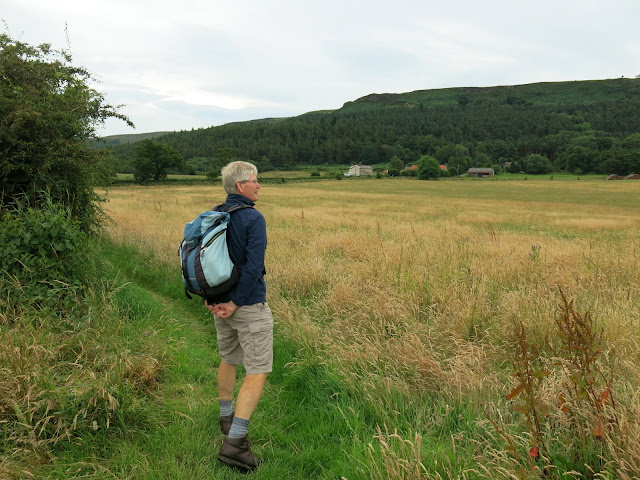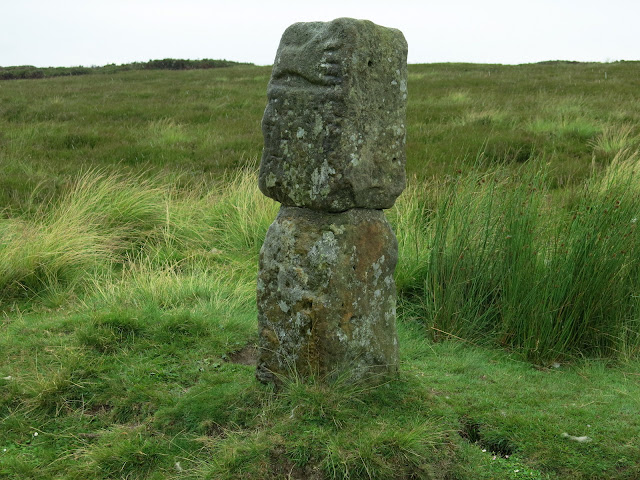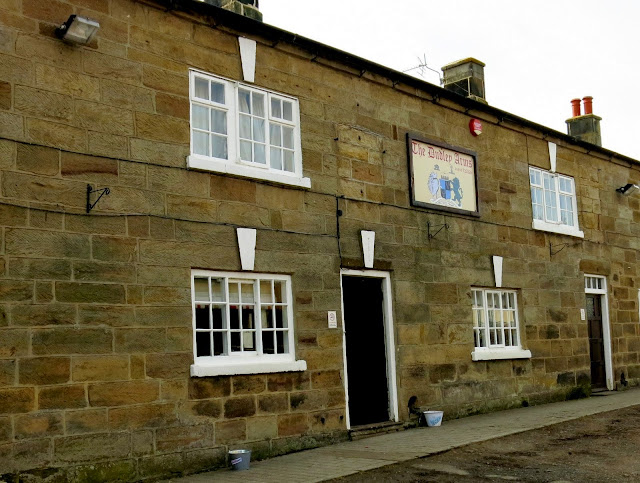The Rosedale Railway and Botton Head from Ingleby Greenhow
8.5 miles Dull and wet
Tom Scott Burns says in his Walker's Guide to the Cleveland Hills, that the name Ingleby has been written in various ways over the years including Angleby, Engelbi, Yngleby and Yngylby. During the reign of William 11 (1087-1100) Guy de Baliol was granted the barony of Ingleby and it remained in his family until the 13th century.
We parked in Ingleby Greenhow in the
overflow car park for the Dudley Arms and walked back to the main road,
in the direction of Kildale. Our route left the road alongside a newly built house and we followed an overgrown path onto meadows.
 |
| Today's walk from The Walker's Guide to the Cleveland Hills |
|
 |
| The Old Vicarage, Ingleby Greenhow |
 |
| Turning off the road into... |
 |
| ...a path between houses |
 |
| .... which emerges onto meadows |
Apart from the moorland trails our paths today were little walked and overgrown in most places. We crossed several meadows to arrive at Bank Foot Farm, situated under Turkey Nab, which is
probably derived from the old personal name Thorlkil. Tom Scott Burns
says in his Walker's Guide that in 1729 William Parkin was hung from
gallows mounted on Turkey Nab for murdering his brother-in-law at Great
Broughton.
 |
| Crossing meadows towards Bank Foot |
 |
| Looking back towards Ingleby Manor |
 |
| Turkey Nab and Bank Foot Farm appear in the distance |
 |
| Unusual sheep near Bank Foot, possibly a Cotswold? |
 |
| What do you mean, funny looking? |
We joined the bed of the old railway track at Bank Foot and turned right to walk towards the Incline bottom. After a couple of miles we passed by some old railway cottages and reached the stiff gradient of the old incline railway. We climbed steadily and passed by some old graffiti of a man wearing a stovepipe hat with a bird in front of his face. TSB suggests that this is a satirical caricature carved by a railway navvy in a moment of inactivity. We were pleased to see that someone had scraped grass and soil away from it to prevent it disappearing into the embankment.
 |
| The old railway bed |
 |
| Passing railway cottages |
 |
| We reach the bottom of the incline railway |
 |
| Forestry work has cleared a lot of trees from the side of the incline |
 |
| Looking over towards old mine workings from the incline |
 |
| A Navvy's graffiti? |
 |
| Looking back down the incline from our coffee stop |
|
The weather seemed to be changing for the worse and we realised that once on the top we would have no shelter so we decided to sit at the side of the incline to enjoy our coffee and scones, with a fine view back towards Ingleby Greenhow. As we got to our feet to continue the walk rain started to fall and would continue for the rest of today's walk.
 |
| Approaching the top |
 |
| Remains of the old winding house | | | |
|
To see some photos of how the old railway and winding house looked in its heyday, it is worth looking at this page.Click Here! The line itself was officially closed on 13th June 1929.
We reached the top and continued to follow the old railway bed, now in a steady downpour. The line used to run eleven miles from the incline summit to Rosedale Bank Top and never dropped below an altitude of 1000 feet. The disused track now makes an excellent footpath to Farndale, Westerdale and Rosedale.
 |
| The old railway to Rosedale |
 |
| This bench made a convenient stop to don my leggings |
 |
| The view deteriorated in the rain |
 |
| We leave the old railway track |
We turned right off the old railway and joined a trail to Cockayne Head and Botton Head, which is also part of the Cleveland Way. As we walked this trail we came to two old boundary posts, the first known as The Face Stone is mentioned in a 1642 document for the Helmsley Estate, and the second showing a carved hand near to Round Hill dates from 1711. Near the Hand Stone is the trig point at Botton Howe which is located on a Bronze Age burial mound at 1490 feet, the highest point on the North York Moors.
 |
| 'Life imitates art far more than art imitates life' Oscar Wilde |
 |
| The Hand Stone |
 |
| Trig Point at Botton Howe |
We walked back to the wide path and
continued walking across Urra Moor, which according to TSB derives from
the Old English 'horh' meaning 'filth'! Eventually we came to a
signpost and an indistinct path right which we followed to quickly drop
off the moor down Jacksons Bank and into Greenhow Plantation.
 |
| Sharp right to Jackson's Bank |
 |
| Starting the descent of Jackson's Bank |
 |
| Have you never seen a brolly before? |
 |
| Jackson's Bank |
 |
| Leaving Greenhow Plantation |
We reached the lane down Greenhow
Bottoms and over to the right we could see the incline railway while ahead
of us Roseberry Topping appeared in the distance. A mile or so further on the tarmac lane and we reached Low
Farm where we stopped to feed an apple to a horse and foal. We turned right, following a footpath sign into Low Farm where we admired their 'ancient' stone circle.
 |
| The incline railway can be seen opposite |
 |
| Cows are too wet to bother chasing us |
 |
| A fine display of Rosebay Willowherb |
Our path turned left before the farm
buildings into fields which we crossed, one after another, on an unseen
right of way, aiming for the yellow right of way signs at the field
boundaries.
 |
| Horses at Low Farm |
 |
| An apple is very welcome |
 |
| Stone Circle at Low Farm |
 |
| Appropriate weather vane at Low Farm |
 |
| An unwalked path through the fields |
After a mile of field walking our path veered right into bushes and descended on a slippery paved trod to reach the bridge over Ingleby Beck, and next to the bridge, the old church of St Andrews.
 |
| Slippery descent to Ingleby Beck |
 |
| St Andrew's Church |
The church was unlocked so we entered and had a look around. The original church was granted to the Bishops of Whitby in 1143 by Adam de Ingleby and still retains traces of Norman work, we liked a nice pig effigy on one pillar. Apparently the church was rebuilt at the parishioners' expense in 1741.
 |
| Looking towards the altar |
 |
There are two recumbent effigies, one of
a knight (probably C15)... |
 |
| .... and the other, a priest (Willimus Wrelton, incumbent c.1300), |
 |
| Original Norman carvings, a dragon? |
 |
| ... and a boar or pig |
 |
| The altar window |
 |
| List of donations |
 |
| St Andrew's Church, Ingleby Greenhow |
|
|
 |
| The Dudley Arms |
Leaving the church, we found we were near the Dudley Arms, which has been an inn since the 1750s and is an ideal place to relax with a pint after a walk, so we did! We agreed this walk of TSB's is enjoyable, with a bit of everything, hills, moors, farms and woods and deserves to be walked more to prevent many of the paths falling into disuse.
